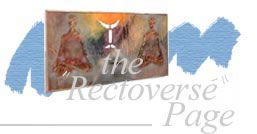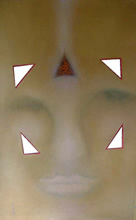 |
 |
|
The "rectoversé" page |
N° 6 | |||||||||||||||
Mystery and painting |
quotations André MALRAUX |
|||||||||||||||
|
||||||||||||||||
 |
 |
|||||||||||||||
| virtual front or back |
virtual back or front |
|||||||||||||||
| "Secret
Egypt" "rectoversé" painting oil on perforated wood panel 250 x 153 cm (X2) |
||||||||||||||||
|
(continuation of the "rectoversé" page N°4 & N°5) |
||||||||||||||||
|
A "rectoversé" painting is not a standard double-sided painting. The openings which cross it right through give ita totally different bearing. The spectator who looks at one of the two full sides of a "rectoversé" painting at the same time sees the third side made up of vacuum. This opening makes him want to see not only behind the painting but also to look through the picture. This is why the "rectoversion", by helping the spectator "to perforate what is visible", updates the ancestral statement according to which any artistic painting contains a share of the inexpressible which always exceeds what it can express itself. If it is the third face in particular which helps the spectator to go in this direction, it is because it helps him in an objective manner. He really sees through the two faces, it is not his mind deceiving him. The famous expressions "go and see behind the mirror " and " pass through the mirror " are totally real here. The third face is materially identical on both sides of the "rectoversé" painting. The virtual front, associated symbolically with the rational, light and the straight line is familiar with this inexpressoble side of things. The same is true for the virtual back which is associated symbolically with the irrational, shadow and the spiral line. André Malraux talked about the mystery that is inherent
in art. You will find some intriguing comments made by this surprising
man in the "quotations of the month". |
||||||||
|
MdC |
||||||||
|
" The Spirit does not possess its own shape; |
||||||||
|
(Chinese pictorial art) |
||||||||
|
- 'quotation of the month' (click at the top of the page on
the right) : ANDRE MALRAUX - |
||||||||
|
For further information, please contact
us. |
||||||||